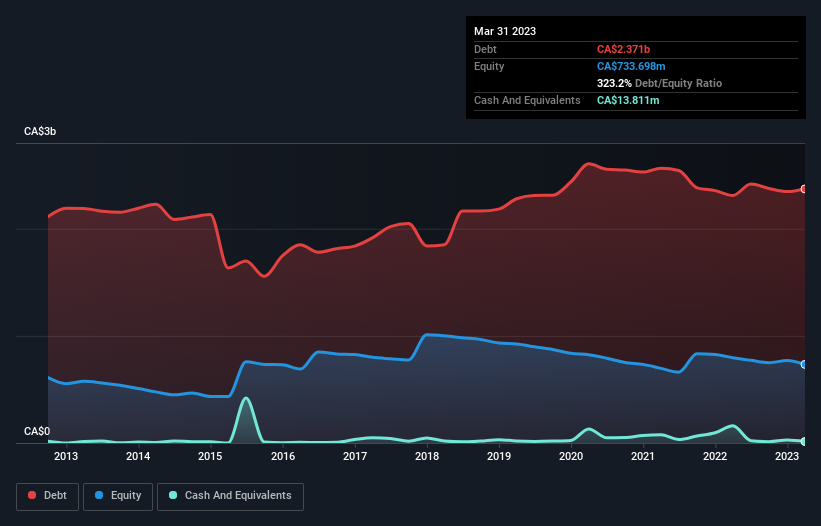- Canada
- /
- Healthcare Services
- /
- TSX:CSH.UN
Chartwell Retirement Residences (TSE:CSH.UN) Takes On Some Risk With Its Use Of Debt

Legendary fund manager Li Lu (who Charlie Munger backed) once said, 'The biggest investment risk is not the volatility of prices, but whether you will suffer a permanent loss of capital.' So it seems the smart money knows that debt - which is usually involved in bankruptcies - is a very important factor, when you assess how risky a company is. Importantly, Chartwell Retirement Residences (TSE:CSH.UN) does carry debt. But the real question is whether this debt is making the company risky.
When Is Debt Dangerous?
Debt and other liabilities become risky for a business when it cannot easily fulfill those obligations, either with free cash flow or by raising capital at an attractive price. In the worst case scenario, a company can go bankrupt if it cannot pay its creditors. While that is not too common, we often do see indebted companies permanently diluting shareholders because lenders force them to raise capital at a distressed price. By replacing dilution, though, debt can be an extremely good tool for businesses that need capital to invest in growth at high rates of return. When we examine debt levels, we first consider both cash and debt levels, together.
See our latest analysis for Chartwell Retirement Residences
What Is Chartwell Retirement Residences's Net Debt?
The chart below, which you can click on for greater detail, shows that Chartwell Retirement Residences had CA$2.37b in debt in March 2023; about the same as the year before. Net debt is about the same, since the it doesn't have much cash.

A Look At Chartwell Retirement Residences' Liabilities
According to the last reported balance sheet, Chartwell Retirement Residences had liabilities of CA$811.4m due within 12 months, and liabilities of CA$1.94b due beyond 12 months. On the other hand, it had cash of CA$13.8m and CA$30.0m worth of receivables due within a year. So it has liabilities totalling CA$2.71b more than its cash and near-term receivables, combined.
Given this deficit is actually higher than the company's market capitalization of CA$2.34b, we think shareholders really should watch Chartwell Retirement Residences's debt levels, like a parent watching their child ride a bike for the first time. In the scenario where the company had to clean up its balance sheet quickly, it seems likely shareholders would suffer extensive dilution.
In order to size up a company's debt relative to its earnings, we calculate its net debt divided by its earnings before interest, tax, depreciation, and amortization (EBITDA) and its earnings before interest and tax (EBIT) divided by its interest expense (its interest cover). Thus we consider debt relative to earnings both with and without depreciation and amortization expenses.
Chartwell Retirement Residences shareholders face the double whammy of a high net debt to EBITDA ratio (11.9), and fairly weak interest coverage, since EBIT is just 0.48 times the interest expense. This means we'd consider it to have a heavy debt load. Looking on the bright side, Chartwell Retirement Residences boosted its EBIT by a silky 46% in the last year. Like the milk of human kindness that sort of growth increases resilience, making the company more capable of managing debt. There's no doubt that we learn most about debt from the balance sheet. But ultimately the future profitability of the business will decide if Chartwell Retirement Residences can strengthen its balance sheet over time. So if you want to see what the professionals think, you might find this free report on analyst profit forecasts to be interesting.
Finally, a company can only pay off debt with cold hard cash, not accounting profits. So we clearly need to look at whether that EBIT is leading to corresponding free cash flow. Over the last three years, Chartwell Retirement Residences actually produced more free cash flow than EBIT. That sort of strong cash conversion gets us as excited as the crowd when the beat drops at a Daft Punk concert.
Our View
While Chartwell Retirement Residences's interest cover has us nervous. To wit both its conversion of EBIT to free cash flow and EBIT growth rate were encouraging signs. We should also note that Healthcare industry companies like Chartwell Retirement Residences commonly do use debt without problems. We think that Chartwell Retirement Residences's debt does make it a bit risky, after considering the aforementioned data points together. That's not necessarily a bad thing, since leverage can boost returns on equity, but it is something to be aware of. When analysing debt levels, the balance sheet is the obvious place to start. But ultimately, every company can contain risks that exist outside of the balance sheet. We've identified 4 warning signs with Chartwell Retirement Residences (at least 3 which shouldn't be ignored) , and understanding them should be part of your investment process.
At the end of the day, it's often better to focus on companies that are free from net debt. You can access our special list of such companies (all with a track record of profit growth). It's free.
New: AI Stock Screener & Alerts
Our new AI Stock Screener scans the market every day to uncover opportunities.
• Dividend Powerhouses (3%+ Yield)
• Undervalued Small Caps with Insider Buying
• High growth Tech and AI Companies
Or build your own from over 50 metrics.
Have feedback on this article? Concerned about the content? Get in touch with us directly. Alternatively, email editorial-team (at) simplywallst.com.
This article by Simply Wall St is general in nature. We provide commentary based on historical data and analyst forecasts only using an unbiased methodology and our articles are not intended to be financial advice. It does not constitute a recommendation to buy or sell any stock, and does not take account of your objectives, or your financial situation. We aim to bring you long-term focused analysis driven by fundamental data. Note that our analysis may not factor in the latest price-sensitive company announcements or qualitative material. Simply Wall St has no position in any stocks mentioned.
About TSX:CSH.UN
Chartwell Retirement Residences
Chartwell is in the business of serving and caring for Canada's seniors, committed to its vision of Making People's Lives BETTER and to providing a happier, healthier, and more fulfilling life experience for its residents.
Average dividend payer slight.
Market Insights
Community Narratives



